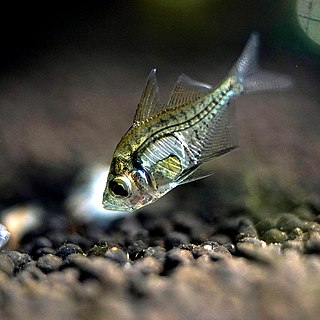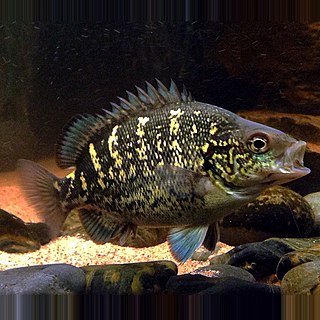
Parambassis is a genus of freshwater fish in the Asiatic glassfish family Ambassidae of order Perciformes. The type species is the Iridescent glassy perchlet. These fishes originate mostly from Southeast Asia, but the species range across the Indomalayan and Australasian realms, from Pakistan, China and India south through Indonesia, New Guinea and Australia. Although primiarly found in fresh water, a few species can also be seen in brackish water. The Parambassis species range in maximum size from 4–24 cm (1.5–9.5 in), but they are similar in appearance, with a lozenge-shaped form, typical perciform fins, and semitransparent or transparent body. Several of the species are common food fish in local markets, and some are kept as aquarium fish.

Rainbowfishes are small, colourful freshwater fishes belonging to the family Melanotaeniidae, found in northern and eastern Australia, New Guinea, Sulawesi and Madagascar.

Agassiz's perchlet, also known as Agassiz's glass fish and the olive perchlet, is a species of ray-finned fish in the family Ambassidae. It is semi-transparent with dark scale edges forming a pattern over most of the body. It grows to a maximum of 7.5 cm. It is a macrophyte spawner with adhesive eggs. It is endemic to Australia. It was named for the zoologist Louis Agassiz.

Ambassis is a genus of fish in the family Ambassidae, the Asiatic glassfishes. They are found widely in the Indo-Pacific region, with species in fresh, brackish and coastal marine waters.
The yellow-fin perchlet is a species of fish in the family Ambassidae. It is endemic to Australia where it has only been recorded from the three rivers which drain into the Gulf of Carpentaria in northern Queensland. They are found in freshwater creeks and rivers with marginal vegetation, frequently recorded from freshwater streams that have quite high turbidity levels.

The bluespotted trevally, also known as the wide-mouthed trevally, is a species of moderately large marine fish in the jack family Carangidae. The bluespotted trevally is distributed through the tropical east Indian and west Pacific Oceans, ranging from Taiwan in the north to Australia in the south. It is an inshore species, found in sandy, muddy and seagrass environments, often in large bays. The bluespotted trevally is distinguished by dark blue spots on its upper body, as well as a number of more detailed anatomical features. It is a benthopelagic predator, taking a variety of crustaceans including crabs and prawns as a juvenile, before shifting to a more fish-dominated diet as an adult. It is one of the most common predators in the Gulf of Carpentaria of northern Australia, and is considered the most important predator of commercially important prawn species. Sexual maturity is reached at 110 mm in length and one year of age, with spawning occurring year round with a peak in spring. Growth is estimated to be 82.2 mm per year for both sexes, reaching a maximum known length of 66 cm. Bluespotted trevally are commonly taken as bycatch in prawn fisheries, however are of little commercial value and often discarded. They are occasionally taken by anglers on lures and baits, but are considered mediocre table fare.

Neoarius berneyi, the highfin catfish, Berney's catfish, Berney's shark catfish, or the lesser salmon catfish, is a freshwater sea catfish that is commonly kept in aquariums. The origin of the name Neoarius berneyi is Greek, with the genus name Neoarius coming from the words neos meaning new and arios, meaning warlike or hostile, in reference to the well developed fin spines, and the species name, berneyi, comes from the ornithologist F. L. Berney.

Toxotes chatareus, sometimes known by the common names common archerfish, seven-spot archerfish or largescale archerfish, is a species of perciform fish in the archerfish genus Toxotes.

The sooty grunter, also known by the name black bream, blubberlips, Northern grunter or purple grunter, is a species of freshwater ray-finned fish, a grunter from the family Terapontidae. It inhabits coastal and inland freshwater creeks and rivers of northern Australia.

The fringefin trevally, also called fringe-finned trevally, round-finned trevally or reef herring, is a species of inshore marine fish classified in the jack and horse mackerel family Carangidae. A relatively small fish, the fringefin trevally is known to reach 40 cm (16 in), but is mostly encountered at lengths less than 25 cm (9.8 in). The fringefin trevally has an ovate body, with distinctive orange-yellow fins and a black opercular spot. The dental patterns of the species distinguish it from the closely related scads of the genus Alepes. Males have characteristic elongated dorsal and anal fins which produce a series of trailing filaments. The fringefin trevally is restricted to the waters of the Indo-Pacific, ranging from northern Australia to Papua New Guinea and eastern Indonesia. An inshore species, it is found in coastal and estuarine environments and exhibits daily and seasonal movements. The fringefin trevally is predatory, taking crustaceans as prey. The species is often taken as bycatch in prawn trawls and occasionally taken by anglers.

Hephaestus carbo, the coal grunter or black grunter, is a species of freshwater ray-finned fish, a grunter from the family Terapontidae. It is endemic to rivers in northern Australia.

Parambassis pulcinella, the humphead glassfish or humphead perchlet, is a species of Asiatic glassfish native to fast-flowing streams in the Ataran basin in southeast Myanmar and west Thailand. It reaches a length of 10 cm (3.9 in) and is sometimes seen in the aquarium trade. It is a relative of the perch.

The Pacific blue-eye is a species of fish in the subfamily Pseudomugilinae native to eastern Australia. Described by Austrian naturalist Rudolf Kner in 1866, it comprises two subspecies that have been regarded as separate species in the past and may be once again with further study. It is a common fish of rivers and estuaries along the eastern seaboard from Cape York in North Queensland to southern New South Wales, the Burdekin Gap in central-north Queensland dividing the ranges of the two subspecies.
Ambassis marianus, commonly known as the estuary perchlet, Ramsay's glassfish, estuary glassfish or glass perchlet, is a species of fish in the family Ambassidae. It is native to coastal eastern Australia. It gains its common name from its transparent appearance.

Ambassis miops, commonly known as the flag-tailed glassfish, is a species of fish in the family Ambassidae. It is native to eastern Australia. It is found only in a few coastal sites along the North Queensland coast. A distinguishing feature of this species is a tiny spine is situated above the rear corner of the eye.

Ambassis nalua, the scalloped glassfish or scalloped perchlet, is a species of fish in the genus Ambassis. It is native to the Indo-Pacific region, form India to Australia and New Guinea, where it occurs in bays, estuaries and mangrove-lined creeks.

Ambassis jacksoniensis, commonly known as the Port Jackson glassfish or Port Jackson perchlet, is a species of fish in the family Ambassidae native to eastern Australia. It gains its common name from its transparent appearance.
Neosilurus hyrtlii, commonly known as Hyrtl's catfish or Glencoe tandan, is a species of catfish found across northern Australia, from the Pilbara to southeastern Queensland.

Neoarius graeffei, or blue salmon catfish, is a species of catfish found in freshwater rivers of Australia and Papua New Guinea. This species is most identifiable by its large, shark-like dorsal fin that is led by a poisonous spine. Like other catfish, the blue salmon catfish is known to use electrical pulses to sense prey in the water. This prey sensing mechanism may be the reason that these catfish are known to eat the land dwelling hopping mouse at a high rate.
Oxyeleotris nullipora, the poreless gudgeon, is a gudgeon of the genus Oxyeleotris, a freshwater fish found in Australia and Papua New Guinea.



















